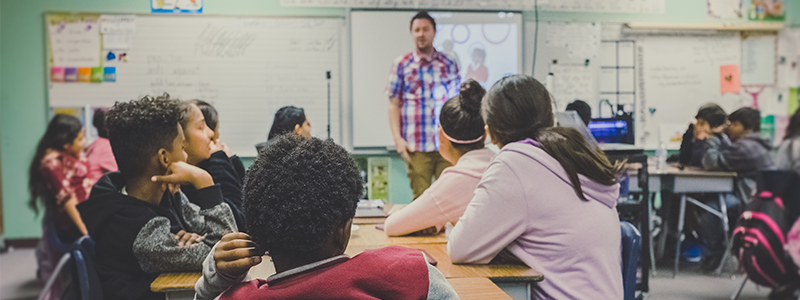When you work in education, you don’t just care about your students; you’re responsible for their well-being. That means you need to prevent the mistreatment of students by their peers. Of course, this is easier said than done. Figuring out how to address bullying in schools can be challenging but necessary. It’s key to providing a safe learning environment for all.
Why It’s Important to Address Bullying in Schools
Bullying can have many serious health and academic consequences. According to the CDC’s research on bullying, it can lead to “physical injury, social and emotional distress, self-harm, and even death. It also increases the risk for depression, anxiety, sleep difficulties, lower academic achievement, and dropping out of school.”
The CDC also states that youth who exhibit bullying behavior “are at increased risk for substance misuse, academic problems, and experiencing violence later in adolescence and adulthood.” Additionally, it’s been shown that those “who bully others and are bullied themselves suffer the most serious consequences and are at greater risk for mental health and behavioral problems.”
That’s why learning how to address bullying in schools is critical to the well-being of each student and improves the overall school culture.
Taking a proactive approach to bullying helps create a safe space for students. It enables them to feel valued and free to focus on learning. Plus, it does more than just stop inappropriate and hurtful behavior. It allows schools to build a foundation for a positive, inclusive, and supportive educational experience, empowering every student to reach their full potential!
What Bullying Looks Like
StopBullying.gov defines bullying as “unwanted, aggressive behavior among school-aged children that involves a real or perceived power imbalance.” It seems simple, but this behavior can take many forms. To address bullying in schools, you need to know what it looks like.
Here are the main types of bullying:
- Verbal bullying – With verbal bullying, offenders use words to hurt others. This type of bullying includes name-calling, insults, and threats. There’s a lot of power in words, which is why verbal bullying can be damaging to students.
- Physical bullying – Often, physical bullying is what comes to mind when we think about bullying. Offenders use aggressive force to harm or intimidate others. It can include kicking, punching, pushing, or any other kind of physical assault.
- Social bullying – With social bullying, a bully’s actions are sneakier and less noticeable. They may spread rumors, exclude someone from groups, or play cruel jokes. The goal is to manipulate relationships and social status to harm the victim.
- Cyberbullying – The first three types of bullying have been around for ages, but this one is newer. Cyberbullying is when bullies harass their victims online through text, email, or social media. They may send hurtful messages or spread false information.
Do Schools Do Enough to Prevent Bullying?
Bullying has been an issue in schools since the beginning. But we didn’t really start to address it until the last few decades. In 2010, the U.S. Department of Education developed the Common Components in State Anti-Bullying Laws, Policies, and Regulations as a framework. And over the years, schools nationwide have implemented strategies to combat bullying.
Yet, research shows that schools may not be doing enough. Bullying is still the top safety concern among elementary, middle, and high school educators. On top of that, one out of five students report being bullied by peers.
Why are these efforts falling short?
- Schools often take a reactive approach.
- Most anti-bullying programs stop at identifying bullying.
- Schools frequently fail to assess if their policies are effective.
- Sometimes, anti-bullying policies aren’t enforced.
- Leaders don’t connect or relate to students.
It’s clear schools could be doing more to prevent bullying behavior. But don’t be discouraged! Part of learning how to address bullying in schools involves finding gaps in current strategies.
Practical Steps for How to Address Bullying in Schools
Are you ready to do more to empower students with the knowledge and skills they need to address bullying in your school?
Here are some practical steps you can take:
1. Implement Clear Anti-Bullying Policies.
First things first, your school should have clear anti-bullying policies in place. Your policies should define bullying behavior and the consequences for perpetrators. More importantly, they should be distributed to everyone in your school. That way, you can ensure everyone understands the rules and expectations.
2. Encourage Kindness and Empathy.
Fostering a culture of kindness and empathy can help prevent bullying. So, strive to include lessons and activities that promote understanding, tolerance, and compassion. Encouraging students to walk in each other’s shoes helps build empathy. Teach students to accept one another’s differences, and bullying will be less likely to thrive.
3. Explain the Effects of Bullying.
Often, bullies don’t realize the enormous impact their actions can have. That’s why explaining the effects of bullying is crucial. Illustrate the emotional, mental, and academic consequences on both sides. Awareness can be a powerful tool to address bullying in schools!
4. Educate Students on Identifying Bullying.
Another big part of how to address bullying in schools is to educate students on the various types. Offer clear examples and scenarios to help them recognize when someone is being treated poorly. This way, you can empower students to become active bystanders. They’ll be more likely to intervene when they see bullying behavior take place.
5. Foster Open Communication and Reporting.
Establishing open lines of communication is essential to creating a safe space for students to share their concerns. Make sure students feel confident their voices will be heard. More than that, allow them to report without fear of retaliation. Outline reporting steps in your policies and offer the chance to report bullying anonymously.
6. Balance Discipline and Compassion.
When addressing bullying incidents, strike a balance between discipline and compassion. Of course, there should be consequences for bullying. But it’s best to include rehab measures and support for both victims and perpetrators. This helps create a learning environment focused on growth and understanding.
7. Practice What You Preach.
Last but not least, model the behavior you want to see! Teachers and administrators play a major role in shaping school culture. Demonstrating kindness, empathy, and respect sets a powerful example for students. When the adults in the school community embody the values they promote, it encourages students to follow suit.
Take Action Now: Join the Movement to Address Bullying Behavior
Now that you better understand how to address bullying in schools, it’s time to take action! Remember – addressing bullying head-on is an investment in your students’ emotional and academic growth. Take the time to reflect on what your school is doing to correct and prevent bullying behavior, and note what might be missing and/or what you might improve.
Dignity Revolution is a comprehensive and evidence-based program that infuses exemplary lessons and activities to address bullying behavior and improve your school’s culture. Learn about the Dignity Revolution today!


